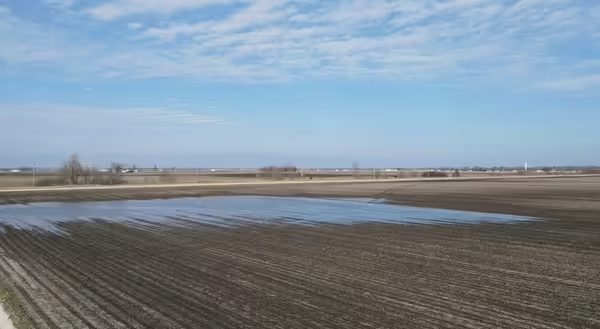
University of Illinois Extension Farm Business Management and Marketing Educator Kevin Brooks has used his years of experience in the private sector to deal with farm drainage problems. Brooks states, "Solving farm drainage issues in an environmentally friendly manner is a lot like putting together a puzzle. Diminishing the Dead Zone in the Gulf of Mexico and protecting our drinking water is of utmost concern. Many communities, such as Peoria, rely on surface water for human water consumption."
By nature, much of the soil dedicated to row crops in Illinois is slow to drain excess water in the form of rain from the root zones of growing crops. This slow soil drainage problem occurs in Fulton, Mason, Peoria, and Tazewell counties. The excess water takes up pore spaces in soil, which reduces oxygen intake of crops, causing plant suffocation and decreased yields.
Saturated soils are subject to compaction, which leads to ponds in fields following heavy rains. Field drainage tile can remove much of the water, but the existing drainage systems have large areas that are inadequate to do so correctly. This results in reduced yields. In addition, due to yield reduction, unused nitrogen and phosphorus fertilizer added to soils to provide essential elements for growing crops moves into our surface and groundwater supplies.
Brooks explains, "Compacted farm fields can have areas where water accumulates and cannot run off the field or percolate down through the soil. Like mudpies created by children, the soil structure becomes smashed together by ponded water and heavy farm equipment. When the soil dries out, the pressure creates a tough layer, which prevents future rainfall from moving through the soil and into drainage tiles. The result is the formation of large ponds right in the field."
Soil compaction causes reduced pore space, which reduces plant uptake of applied fertilizer in nitrogen and phosphorus nutrients. Roots are restricted stunting plant growth and reducing nutrient uptake.
A well-drained farm field allows for plant uptake of more nutrients. Though it is impossible to eliminate all contamination, applying fertilizer in the proper amounts to be used by the plants and helping to ensure the crop uses that fertilizer is a key component. When heavy rains occur, there will be some nutrient loss into our water resources. The key is working to minimize the amount of nutrient loss.
Brooks is working on a Farm Drainage Series of articles, which measures yield gain by implementing improvised drainage and looking at effective alternative solutions.
PHOTO CAPTION
Ponded Farm Field in Illinois
MEET THE AUTHOR
Kevin Brooks became the farm business management and marketing educator serving Fulton, Mason, Peoria, and Tazewell counties in 2022. He previously served in this role from 2000 to 2011 in Effingham and Champaign counties.
Kevin grew up on a corn and hog farm in Iowa. He received his bachelor of science degree in agriculture business from Truman State University and his master of science degree from University of Missouri in agriculture education.
Kevin is a fully licensed managing real estate broker in Mahomet, Illinois.He holds agriculture teaching certifications in Illinois and Missouri. He is also a commercially licensed UAS (drone) pilot holding an FAA Part 107 license.
ABOUT EXTENSION SNAPSHOTS
Extension Snapshots are monthly impact reports that share the stories of our programs in Fulton, Mason, Peoria, and Tazewell counties. To have them delivered to you directly sign up using our E-blast registration.